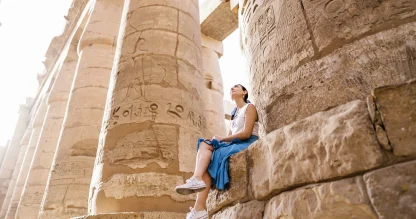An In-Depth Guide to the Giza Pyramids
In the arid, sandy landscape of Egypt lies one of the greatest wonders of the ancient world — the Giza Pyramids. This architectural marvel, standing tall against the test of time, has for centuries been a source of intrigue and fascination. The Giza Pyramids, more than just tombs for the pharaohs, are an embodiment of the grandeur, sophistication, and mysticism of ancient Egyptian civilization.
The Giza Pyramids, located on the outskirts of Cairo, the bustling capital city of Egypt, consist of three primary pyramids — the Great Pyramid of Khufu, the Pyramid of Khafre, and the Pyramid of Menkaure. The Sphinx, another iconic structure, is also part of this majestic complex. These structures have stood for over 4,500 years, intriguing historians, archaeologists, and visitors from around the globe.
These pyramids, primarily known as royal tombs, are the final resting places of the pharaohs — Khufu, Khafre, and Menkaure. The grandest of them all, the Great Pyramid of Khufu, also known as Cheops, is the only surviving structure of the Seven Wonders of the Ancient World.
Historical Significance of the Giza Pyramids
The historical significance of the Giza Pyramids is immense. The construction of these monumental structures dates back to Egypt's Old Kingdom (2686–2181 BC), a period known for its architectural innovation and cultural development. The Giza Pyramids, in particular, symbolize the pinnacle of the pyramid-building era, demonstrating the technical skills and organizational abilities of the ancient Egyptians.
The Giza Pyramids served a dual purpose — a tomb for the deceased pharaoh and a demonstration of the pharaoh's power and wealth. The grandeur and intricacy of these structures reflected the pharaoh's status, providing a gateway for their journey to the afterlife. These pyramids also played a critical role in Egypt's religious and cultural practices, with the surrounding temples and smaller pyramids serving as places of worship and burial grounds for royal family members and high-ranking officials.
Furthermore, the Giza Pyramids have provided substantial insights into the ancient Egyptian civilization, its beliefs, customs, and societal structure. The artifacts and hieroglyphics found within these pyramids have offered valuable information about the lives and reigns of the pharaohs, the religious beliefs of the era, and the evolution of pyramid construction techniques.

The Architecture of the Giza Pyramids
One of the most captivating aspects of the Giza Pyramids is their architectural brilliance. Constructed with an extraordinary level of precision and detail, these structures exemplify the technological prowess of the ancient Egyptians. The Great Pyramid of Khufu, the largest of the three, is a testament to this architectural mastery.
The Great Pyramid, standing at a height of 481 feet, was the tallest man-made structure for over 3,800 years. It is estimated to consist of approximately 2.3 million blocks of limestone and granite, some weighing as much as 80 tonnes. Despite the absence of modern machinery, the ancient Egyptians managed to construct this colossal structure with remarkable accuracy.
The architecture of the Giza Pyramids also reflects the ancient Egyptians' understanding of astronomy. The sides of the Great Pyramid are aligned with the cardinal points — north, south, east, and west, demonstrating their knowledge of the Earth's rotation. Similarly, the layout of the three pyramids mirrors the alignment of the three stars in the Orion's Belt, suggesting a possible celestial significance in their construction.

Unveiling the Mysteries: Theories about the Giza Pyramids
Despite extensive research and exploration, the Giza Pyramids continue to be shrouded in mystery. Over the years, numerous theories about their construction, purpose, and the hidden chambers within have emerged, adding to the intrigue surrounding these structures.
One of the most debated theories pertains to the construction of the pyramids. While it is widely accepted that the pyramids were built using a large workforce over several decades, the exact methods employed remain a mystery. Some theories suggest the use of ramps and levers, while others propose the possibility of advanced technologies unknown to modern science.
Another mystery revolves around the purpose of the pyramids. While they are primarily seen as royal tombs, some researchers argue that the pyramids might have served other purposes, such as astronomical observatories or even energy generators, citing the precise alignment with celestial bodies and the unusual electromagnetic properties within the pyramids.
Secret chambers within the pyramids also fuel the mystery. Recently, using advanced technology like muon radiography and thermal imaging, researchers have discovered anomalies within the pyramids, suggesting the presence of previously unknown chambers and corridors. These findings have sparked renewed interest and speculation about what lies within these ancient structures.

Egyptologists' Research on the Giza Pyramids
Egyptologists have dedicated years of research to unravel the secrets of the Giza Pyramids. Using a combination of archaeology, Egyptology, and cutting-edge technology, they have made significant strides in understanding these remarkable structures.
Excavations and studies have provided insights into the materials used in the construction, the workforce involved, and the time taken to build these pyramids. Egyptologists have also deciphered many of the hieroglyphics found within the pyramids, shedding light on the lives of the pharaohs and their journey to the afterlife.
However, the Giza Pyramids continue to present new challenges and possibilities. The recent discoveries of thermal anomalies and potential hidden chambers have opened new avenues for research, prompting Egyptologists to delve deeper into these mysteries. The ongoing exploration and research are helping to piece together the puzzle of the Giza Pyramids, but there is still much to be discovered.

The Giza Pyramids in Popular Culture
Over the years, the Giza Pyramids have permeated popular culture, featuring prominently in films, literature, music, and art. Their grandeur, mystery, and historical significance have inspired countless works of fiction and non-fiction alike.
From serving as the backdrop for epic adventures in films like "The Mummy" and "Indiana Jones" to featuring in the plotlines of bestselling novels like "The Alchemist" and "River God", the Giza Pyramids have captured the imagination of audiences worldwide. They have also been immortalized in numerous artworks and songs, symbolizing the enduring allure of ancient Egypt.
Moreover, the Giza Pyramids have been the subject of numerous documentaries and TV series, exploring their history, architecture, and the mysteries that surround them. These portrayals in popular culture have only added to the fascination with the Giza Pyramids, making them one of the most recognized and celebrated landmarks in the world.

Tourism at the Giza Pyramids: What to Expect
Visiting the Giza Pyramids is a bucket-list experience for many. As one of the most popular tourist destinations in Egypt, the Giza Pyramids offer an unforgettable journey into the ancient world. From marveling at the architectural brilliance of the pyramids to exploring the surrounding temples and tombs, a visit to the Giza Plateau is a step back in time.
Tourists can explore the interiors of the Great Pyramid and the Pyramid of Khafre, witnessing the narrow corridors and burial chambers firsthand. The Sphinx, another highlight of the complex, is a sight to behold with its lion's body and human head. The panoramic view of the pyramids against the backdrop of the Cairo skyline from the Giza Plateau is another unforgettable experience.
Additionally, visitors can immerse themselves in the rich history and culture of ancient Egypt through guided tours, museum exhibits, and light and sound shows that bring the story of the pyramids to life. From the awe-inspiring structures to the captivating tales of pharaohs and gods, a visit to the Giza Pyramids is a journey into the heart of ancient Egypt.

Tips for Visiting the Giza Pyramids
Visiting the Giza Pyramids can be an overwhelming experience, given their scale and significance. Here are some tips to make the most of your visit. Plan your visit early in the morning or late in the afternoon to avoid the midday heat and crowds. Hiring a knowledgeable guide can enhance your experience, providing insights into the history, architecture, and mysteries of the pyramids.
While exploring the interiors of the pyramids is a unique experience, be prepared for narrow, steep passages and limited ventilation. Comfortable footwear is a must, given the sandy terrain and the amount of walking involved. Also, remember to respect the site by not climbing the pyramids or taking away any stones.
Lastly, make time to visit the Solar Boat Museum, home to a reconstructed solar ship intended for the pharaoh's journey to the afterlife. A sunset camel ride on the Giza Plateau, offering stunning views of the pyramids, can be a perfect end to your visit.

Happy Travellers with Cairo Nile Cruise!
Take a look at our top Egypt Tours reviews, where you will find firsthand insights from our very own Intrepid travellers.









